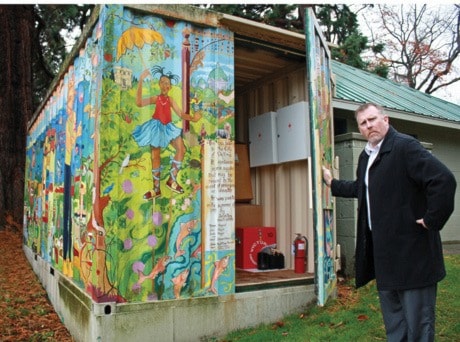Kids sometimes climb on them. Other people admire the murals painted on their sides. Most walk by without a second thought as to their contents.
Victoria’s emergency supply containers keep a low profile, stationed primarily in parking lots throughout the municipality. But in the case of a catastrophe – such as a major earthquake that forces people from their homes – these containers will play a vital role in keeping evacuees safe and warm.
“Once an earthquake occurs, the city would assess areas of need and likelihood of displaced people,” said Rob Johns, Victoria’s emergency co-ordinator. “The challenge is that we can’t predict what buildings will be useful to us.”
That means it could take a whole day after disaster strikes before potential facilities can be assessed for damage, he said. Once Johns’ team can identify safe facilities, it will publicize the addresses through media and posters. Emergency workers will set up reception centres and lodging centres for evacuees.
That’s where the containers come in. Appointed volunteers will fan out as needed to open the various containers and bring supplies to the evacuation centres. In total, 10 containers hold 11,000 cots, 2,000 blankets and other supplies, such as small hand tools and the paperwork needed to register evacuees. There are no food or water supplies inside.
The city’s annual budget for emergency supplies is $25,000. Every two years the city adds more containers or equipment to its evacuee assistance program, with Oaklands next on the list.
The neighbourhood already has a container, but no contents as of yet.
Johns calls them starter supplies, to tide relief efforts over until further assistance arrives from the federal or provincial government.
It’s a system that gets tested on a small scale regularly.
Ten to 20 times per year, apartment fires cause evacuations. “Those are real-life events that happen on a somewhat regular basis,” said Johns.
He estimates the containers have served 2,000 people.
It’s also a system that relies on many volunteers.
The Victoria Emergency Management Agency has a team of 45 regular volunteers plus a few more reserves. After a major emergency, Johns will initiate the large-scale callout for hundreds of new volunteers to chip in. But it takes hours or even days to bring those people in, give them an orientation and assign them to a task, he said.
The key is to have a group of core volunteers trained in advance, he added.
The city is hosting a volunteer recruitment session on Monday, Nov. 26 from 7 to 9 p.m. at the Oaklands Community Centre, 2827 Belmont Ave. Volunteers must be at least 19, be calm under pressure, and must undergo a criminal record check. Free training is provided.
To register, call 250-920-3373. For more information, visit PrepareVictoria.ca.
Surge of earthquakes likely not linked
Three significant earthquakes in three weeks along B.C.’s coastline has left Victorians wondering: are we next? Earthquake expert John Cassidy says all this seismic activity nearby does not signal we’re at greater risk of the Big One soon.
“It’s no higher or lower than it normally is,” said Cassidy, a seismologist and researcher with the Geological Survey of Canada.
“We don’t know for sure, but we don’t think that they are linked directly, because they are on different fault systems.” But, he qualified, they could be linked in ways scientists don’t yet understand.
A magnitude 7.7 earthquake rocked Haida Gwaii and B.C.’s northern coast Oct. 27. On Nov. 7, a magnitude 6.3 quake occurred southwest of Port Hardy and on Nov. 12, a 6.4 magnitude shaker was centred in the Gulf of Alaska. “It’s a good reminder for people that we live in a very active earthquake zone,” Cassidy said.
His research focuses on how the ground shakes differently throughout a region, depending on soil type. “If people feel an earthquake, it’s very helpful if people tell us,” he said.
To help with this project, visit earthquakescanada.ca and follow the link ‘Did you feel it?’
rholmen@vicnews.com
